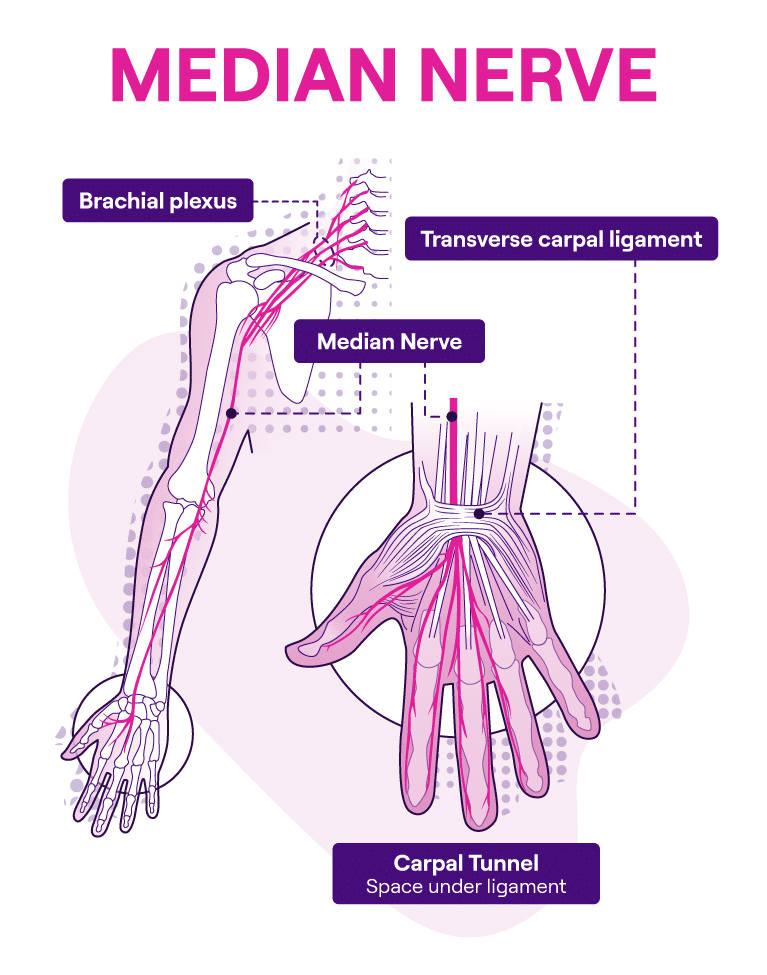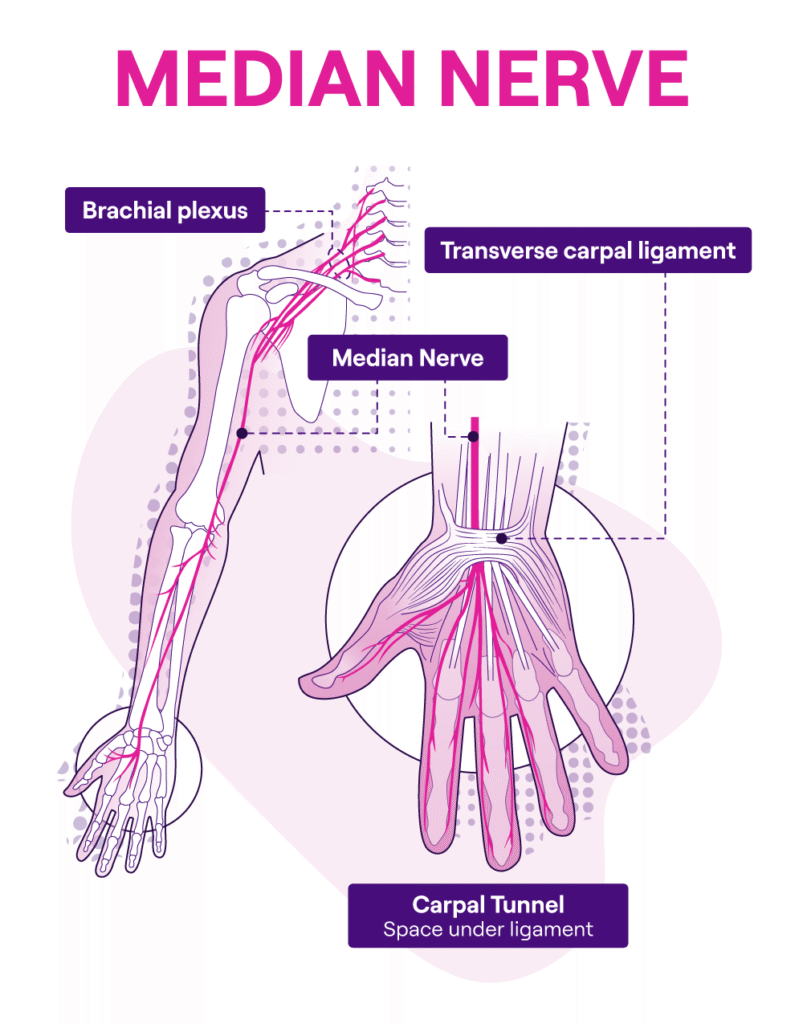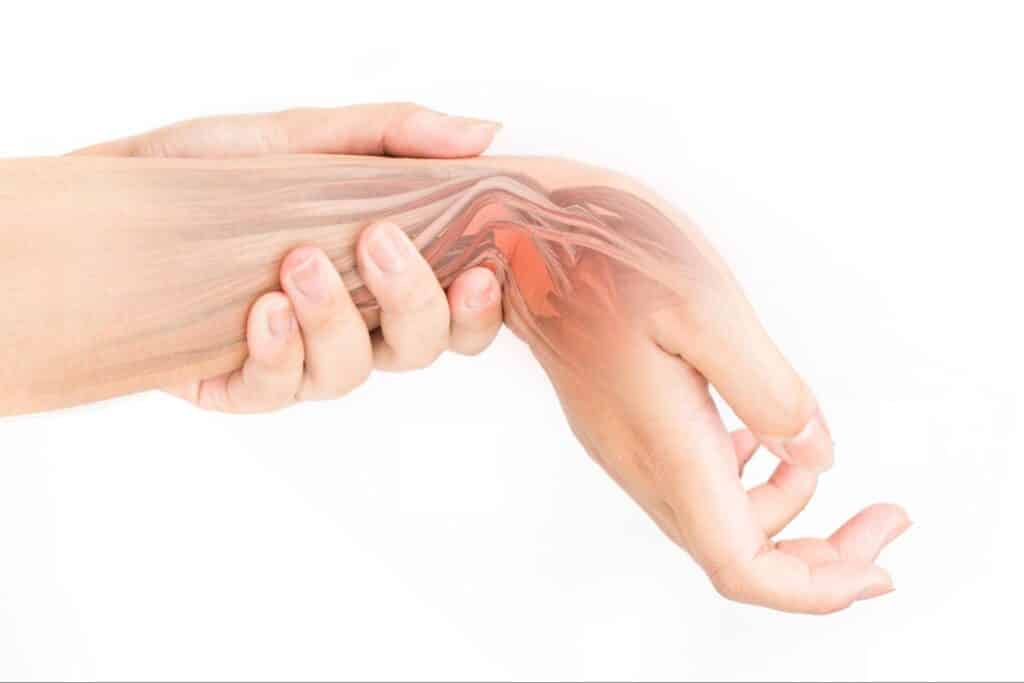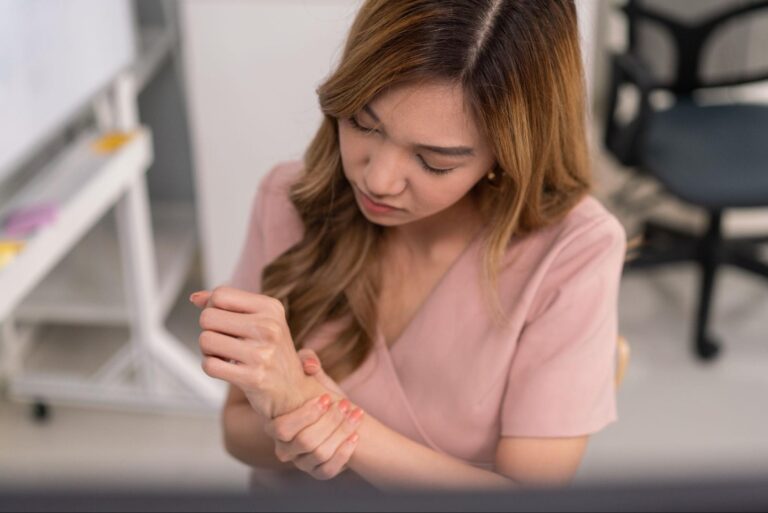The median nerve is a crucial link in the network of nerves that enable a broad range of hand and wrist movements. Tasks like typing, gripping, or turning a doorknob rely on the median nerve’s ability to transmit signals for both sensation and fine motor control. When issues such as carpal tunnel syndrome (CTS) develop, the median nerve becomes compressed, resulting in tingling, numbness, and sometimes pain. This article explores the anatomy and function of the median nerve, its connection to CTS, and steps you can take to maintain healthy nerve function.
Understanding how the median nerve operates offers valuable insights into prevention and early intervention. From diagnostic methods—like real-time diagnostic ultrasound—to various treatment approaches, including lifestyle adjustments and more advanced procedures, there is a range of options for addressing median nerve–related challenges. Whether you are in the early stages of noticing unusual hand and wrist sensations or seeking ways to prevent complications, this overview can help guide your decisions.
Below, we will examine the path of the median nerve from the arm to the hand, note its vital functions, and reveal how compression in the narrow confines of the carpal tunnel contributes to CTS. We will also explore diagnostic strategies like ultrasound, nerve conduction studies and electromyography, plus conservative and office-based treatments that may help relieve symptoms. By the end, you will be equipped with key information on protecting your median nerve and making informed decisions about your wrist and hand health.
What is the Median Nerve?
The median nerve serves as one of the principal nerves supporting the hand and wrist. It plays a dual role: providing sensation to parts of the hand (particularly the thumb, index finger, middle finger, and half of the ring finger) and enabling fine motor control for pinch and grip strength. Any disruption to these functions can interfere with basic tasks—like buttoning a shirt or writing a note—and may diminish overall quality of life.
One common cause of median nerve disruption occurs when it is compressed within the carpal tunnel. In CTS, this compression typically triggers symptoms such as numbness, tingling, and pain in the wrist and hand. These sensations can also radiate up the forearm. Repetitive tasks, hormonal changes, or inflammation in the wrist can increase pressure around the nerve, leading to discomfort or limited mobility.
Appreciating how the median nerve works lays the groundwork for understanding CTS. By recognizing where and how compression takes place, individuals who experience hand and wrist issues can more readily identify the cause and explore appropriate interventions, whether conservative or procedural.
Anatomy of the Median Nerve


Origin and Pathway
The median nerve originates from the brachial plexus, a network of nerves in the shoulder region. From there, it travels down the arm, passing through the forearm muscles. As it enters the wrist, the nerve passes through the carpal tunnel, a narrow passage bounded by carpal bones on the bottom and a ligament on the top. In this tunnel, the nerve accompanies flexor tendons, all vying for limited space.
Hand and Wrist Involvement
Once the median nerve emerges into the hand, it splits into branches to serve different fingers. It provides both sensory and motor fibers, enabling you to feel objects in your grasp and accurately perform tasks like typing or picking up small items. Because the median nerve supports muscles at the base of the thumb, its efficient functioning is especially crucial for pinching and gripping.
Vulnerability to Compression
While the carpal tunnel’s narrow shape helps keep tendons and the median nerve neatly organized, it also means there is not much room for excess pressure. Swelling due to inflammation or fluid retention—sometimes aggravated by certain medical conditions or pregnancy—can cause the walls of the carpal tunnel to push against the nerve. This explains why small changes in wrist structure often have a large impact on comfort and function.
Function of the Median Nerve
Sensory Function
On the sensory side, the median nerve allows you to detect textures, temperatures, and pressures. This skill is vital for everyday tasks—imagine trying to separate two thin pieces of paper without the ability to feel subtle differences in texture or pressure. Even a minor decrease in sensation can disrupt fine motor tasks, highlighting the importance of a healthy median nerve.
Motor Function
Motor signals from the median nerve assist in flexing the wrist and fingers. These signals are especially relevant for forming a solid grip or pinching motion, enabling precision tasks such as tying shoelaces or navigating touchscreens. Compromise to the nerve can lead to weakness and clumsiness in the hand, which can pose challenges at home or in the workplace.
Role of the Median Nerve in Carpal Tunnel Syndrome (CTS)
When individuals develop carpal tunnel syndrome, the median nerve is compressed at the wrist. This compression usually arises from activities or conditions that increase pressure within the carpal tunnel. CTS affects millions worldwide and is often triggered by repetitive movements, fluid retention, or certain medical conditions:
- Repetitive hand and wrist movements, such as typing or assembly-line work
- Pregnancy or hormonal changes leading to fluid retention
- Certain medical conditions that involve swelling or inflammation
- Injury or trauma that narrows the carpal tunnel
If left unaddressed, the pressure can result in persistent numbness, tingling, or weakness in the hand. While carpal tunnel syndrome commonly appears in office workers, it also affects many people engaged in tasks requiring repeated wrist flexion or gripping. Early recognition lets you take steps to prevent further nerve damage, reducing the risk of long-term complications.
Diagnosing Median Nerve–Related Issues
Importance of Early Evaluation
Early signs of CTS or other median nerve complications can include nocturnal tingling, difficulty holding objects, or a gradual loss of fine motor coordination. Healthcare providers often encourage prompt assessment because an early evaluation may notably impact outcomes. Mild cases could respond well to conservative measures, whereas severe cases might necessitate more in-depth diagnostic tests or procedural intervention.
Diagnostic Tools May Include:
- Physical Examination: A physician might perform tests like Tinel’s sign, where lightly tapping near the wrist elicits tingling if the median nerve is irritated.
- Real-Time Diagnostic Ultrasound: By positioning a transducer on the skin, clinicians can visualize the median nerve directly. This real-time approach is efficient, painless, and patient-friendly compared to certain other diagnostic methods. Because ultrasound shows immediate images on a screen, providers can detect swelling or structural issues on the spot. It can also be quicker and more cost-effective than other imaging tools that require separate processing or exposure to radiation.1
- Nerve Conduction Studies: Using electrodes on the skin, nerve conduction studies measure how fast an electrical impulse moves through the median nerve, identifying areas of slowed or blocked conduction.
- Electromyography (EMG): Through tiny needle electrodes, electromyography records electrical activity in muscles. Abnormal readings can indicate nerve or muscle dysfunction, helping confirm the extent and origin of the problem.
Together, these tools can confirm compression of the median nerve and rule out other potential causes of symptoms. Securing a thorough diagnosis forms the basis for a targeted, effective management plan.
Take A Symptom Survey
Treatment Options for Median Nerve–Related Conditions
Treatment for carpal tunnel syndrome or other median nerve compression typically starts with conservative measures. These may include:
- Wrist braces to maintain a neutral wrist position, reducing strain
- Targeted exercises to stretch and strengthen the hand and wrist
- Over-the-counter anti-inflammatories and gentle physical therapy
If symptoms persist—or if nerve damage appears more advanced—your healthcare provider may suggest procedural options. One established approach is traditional open carpal tunnel release, during which the ligament forming the roof of the carpal tunnel is cut to alleviate pressure on the nerve. Another approach, endoscopic carpal tunnel release, involves the use of a tiny camera to guide the procedure, reducing the size of the incision compared to a traditional release.
For some individuals, a minimally invasive technique known as carpal tunnel release with ultrasound guidance (CTR-US) may be considered. CTR-US may be performed in a clinic or office-based setting under local anesthesia, using ultrasound imaging to visualize structures around the median nerve.2-5 By directly seeing the median nerve and surrounding tissues in real time, healthcare providers may address nerve compression without a large incision.3,4,6 This office-based approach often corresponds with shorter recovery periods than traditional methods, enabling a faster return to daily tasks.2-4 Please discuss the risks and benefits of this procedure with your healthcare provider.
Preventative Measures for Maintaining Median Nerve Health

In many cases, proactive steps may reduce strain on the median nerve and curb or delay carpal tunnel syndrome onset. As mentioned by OrthoInfo from the American Academy of Orthopaedic Surgeons, early adjustments may help you avoid long-term complications:
- Adjust Wrist Position: Maintaining a neutral wrist can help minimize pressure on the median nerve. If you work long hours at a desk, consider using an ergonomic keyboard and mouse to reduce repetitive wrist extension or flexion. Tools such as wrist pads can remind you to keep your wrists level with your forearms.
- Ergonomic Workspace: A well-designed work environment can alleviate undue stress. Simple changes like adjusting chair height to keep your feet flat on the floor, angling your monitor slightly below eye level, and selecting supportive armrests go a long way.
- Frequent Breaks: Regularly pausing to stretch and move your wrists, fingers, and arms relieves muscle tension. Even brief stretch breaks every hour can ease tightness and improve circulation.
- Exercises and Strengthening: Targeted exercises, such as gentle fist-to-finger stretches or wrist rotations, may maintain flexibility and support the muscles around the median nerve. Stronger musculature in the forearm and hand can better handle repetitive tasks without overloading the nerve pathway.
- Early Screening: If you notice numbness or tingling that interrupts daily activities or wakes you at night, consult a healthcare practitioner early. An evaluation may be able to detect minor nerve compression before it escalates into chronic pain or functional limitations.
Lifestyle Modifications and Rehabilitation
While consistent preventive measures help avert many median nerve issues, rehabilitation also plays a key role for those already experiencing carpal tunnel syndrome. Depending on the severity and duration of symptoms, recovery strategies can vary:
- Physical and Occupational Therapy: A healthcare practitioner can recommend stretches and exercises tailored to your condition, helping to restore strength and flexibility. Physical therapy may also include modalities like ultrasound or electrical stimulation, further promoting nerve health.
- Activity Modification: Minimizing repetitive wrist flexion or extension, especially when discomfort is present, can help the nerve recover. Simple changes, like altering your workstation or rotating tasks at your job, can provide the nerve with rest intervals. Staying aware of your wrist’s alignment during daily activities can improve outcomes significantly.
- Nerve Gliding Exercises: Some providers recommend nerve gliding exercises designed to help the median nerve move more freely within the wrist. These gentle stretching exercises position the wrist and fingers in various angles, promoting mobility and possibly reducing minor adhesions or points of tension.
- Adequate Rest and Sleep Position: Many individuals unintentionally bend their wrists when sleeping. Using a lightweight wrist brace at night can keep the joint straight and alleviate nerve compression for those prone to flexed-wrist sleeping positions.
Combining these lifestyle and rehabilitation strategies often yields the best long-term results, especially when accompanied by ongoing monitoring of symptoms and professional advice.
Get A Free Screening
Final Words: Enhancing Hand Health Through Median Nerve Care
The median nerve is integral to our hand functionality, facilitating essential tasks like gripping a doorknob or threading a needle. When this nerve faces compression, as seen in carpal tunnel syndrome, everyday activities often become challenging and uncomfortable. Fortunately, numerous strategies—from early assessments to both conservative and advanced procedural treatments—amplify our ability to address these issues effectively.
If you experience persistent tingling, hand weakness, or pain impacting your daily activities, seeking professional help promptly is crucial for early intervention and better outcomes. For individuals already contending with carpal tunnel syndrome, lifestyle adjustments combined with rehabilitation techniques can help manage symptoms and foster nerve health.
Prioritizing the median nerve’s well-being ensures you maintain its pivotal role in hand movements and sensations, promoting comfort and productivity. Whether you identify as an office worker, a devoted parent, or anyone invested in optimal hand health, early attention to median nerve concerns can foster overall well-being.
Take the Next Step Toward Hand Health: Don’t wait until symptoms worsen. For a free screening and personalized guidance, contact us or find a physician today. Your comfort and mobility are just a consultation away.
MP04198rA




